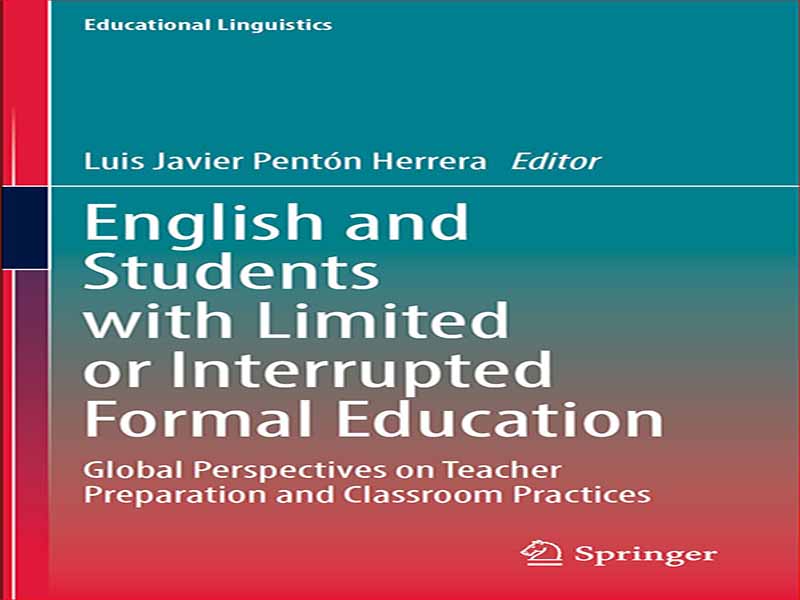- عنوان کتاب: English and Students with Limited or Interrupted Formal Education
- نویسنده/انتشارات: Luis Javier Pentón Herrera
- حوزه: آموزش زبان انگلیسی
- سال انتشار: 2022
- تعداد صفحه: 359
- زبان اصلی: انگلیسی
- نوع فایل: pdf
- حجم فایل: 7.65 مگابایت
من اولین بار با لوئیس خاویر پنتون هررا در کنوانسیون انجمن بین المللی TESOL 2019 در آتلانتا، GA ملاقات کردم. او در مورد تجربیات خود از کار با دانش آموزان دبیرستانی از آمریکای مرکزی صحبت می کرد. جلسه راهنمایی معلم او در پشت سالن نمایشگاه غاردار برگزار می شد که بسیار پر سر و صدا و حواس پرتی بود، اما شرکت کنندگان او در لبه صندلی های خود به شدت برای شنیدن فشار می آوردند زیرا آنچه او به اشتراک می گذاشت جالب بود. اگر چه محیط مطمئناً کمتر از ایده آل بود، پیام توجه آنها و من را جلب کرد. پس از برگزاری کنوانسیون، با لوئیس تماس گرفتم تا ببینم آیا می توانم نسخه ای از ارائه او را دریافت کنم، زیرا شنیدن آن بسیار دشوار بود، و می دانستم که برخی از صحبت های او را از دست داده ام. از آن جلسه یک دوستی و مشارکت حرفه ای رشد کرده است که شامل این کتاب می شود. تجربه من با SLIFE (دانش آموزان با آموزش رسمی محدود یا قطع شده) زمانی شروع شد که در مدرسه راهنمایی در کلمبوس، اوهایو، انگلیسی را به عنوان زبان دوم (ESL) تدریس می کردم. شهر ما به طور سنتی میزبان تعداد زیادی از خانوادههای پناهنده بود، اما وقتی تعداد زیادی از خانوادههای سومالیایی در دهه 1990 شروع به ورود کردند، مطمئن نبودیم که چگونه میتوانیم نیازهای تحصیلی و اجتماعی آنها را به بهترین نحو برآورده کنیم. به قدری بسیاری از بچه ها تجربیات کمی (یا هیچ) قبلی در محیط های رسمی مدرسه داشتند که برنامه نویسی سنتی ما کافی نبود. منطقه یک کارگروه تشکیل داد و بهترین شیوه ها را مورد تحقیق قرار داد و یک برنامه تازه وارد برای دانش آموزان دبیرستانی و راهنمایی ایجاد کرد (به Custodio، 2011 مراجعه کنید). این تجربه منجر به تحقیقات شخصی در زمینه SLIFE شد، اما در آن زمان، اطلاعات کمی در دسترس بود. در سال 2002، من مشتاقانه از کتاب «بستن شکاف پیشرفت: چگونه به یادگیری زبان انگلیسی محدود رسمی و بلندمدت دست یابیم» نوشته ایوون و دیوید فریمن و ساندرا مرکوری (فریمن و همکاران، 2002) را بلعیدم. من شروع کردم به استفاده از مخفف LFS (مدرسه رسمی محدود) به جای مخفف SIFE (دانش آموزان با آموزش رسمی قطع شده) که توسط اداره آموزش و پرورش شهر نیویورک و ایالت در سال 1997 پذیرفته شده بود (به مدافعان کودکان نیویورک مراجعه کنید). ، 2010). هنگامی که من و نویسنده همکارم در سال 2017 کتاب خود را در مورد SIFE با عنوان دانش آموزان با آموزش رسمی منقطع نوشتیم: پل زدن در جایی که آنها هستند و آنچه نیاز دارند (Custodio & O’Loughlin, 2017)، ما از این اصطلاح استفاده کردیم زیرا اصطلاحی بود که با آن ما آشناترین بودیم اصطلاح SLIFE که در این نسخه استفاده شده است برای اولین بار توسط DeCapua، Smathers و Tang در سال 2009 در کتاب آنها با عنوان Meeting the Needs of Students with Limited or Interrupted School ابداع شد. این اصطلاح از آن زمان به دلیل اضافه شدن کلمه “L” به مخفف SIFE محبوب ترین در سراسر جهان برای توصیف این دانش آموزان شده است، و توجه را به این واقعیت جلب می کند که برخی از دانش آموزان در این دسته تجربیات کمی (اگر وجود داشته باشند) داشته اند. در مدارس رسمی قبل از مهاجرت. مخفف SLIFE در سراسر این جلد ویرایش شده استفاده خواهد شد، و نشان می دهد که چگونه این اصطلاح اکنون معمولاً در تنظیمات P-12 و بزرگسالان یافت می شود، اما من خوانندگان را به فصل اشاره می کنم. 2، جایی که Browder، Pentón Herrera و Franco سوالات مهمی را در مورد نام اختصاری و استفاده از آن مطرح می کنند. با گذشت زمان، درک ما از مسائل SLIFE گسترش یافته است و فراتر از توسعه زبانی و آکادمیک ساده است. بنابراین بسیاری از این دانشآموزان موقعیتها و شرایطی را تجربه کردهاند که آسیبهای جسمی، عاطفی و خانوادگی را اضافه کرده است که اغلب به چالشهای تحصیلی آنها میافزاید یا حتی بر آنها سایه میاندازد. ما کشف کردهایم که یک مربی میتواند برای بهبود این موانع بدون آموزش رسمی از طریق فراهم کردن محیطی دلپذیر، روال کلاسی راحت، و برنامه درسی و ذهنیتهای پاسخگوی فرهنگی انجام دهد (DeCapua & Marshall, 2011; O’Loughlin & Custodio, 2021). نویسندگان در فصلهای بعدی پیشنهادهای کاربردی و مشخصی را برای ایجاد کلاسهایی ارائه میکنند که نیازهای آکادمیک و غیر آکادمیک بیشمار SLIFE در سراسر جهان را برآورده میکنند. نگاهی به فهرست مطالب به سرعت نشان می دهد که موضوعات و نویسندگان نشان دهنده تنوع مکان و جمعیت دانش آموزی هستند. مربیان از آمریکای شمالی، کارائیب، آمریکای جنوبی، اروپا، آسیا و خاورمیانه استراتژیهای آموزشی معتبر و عملی مبتنی بر آخرین چارچوبهای نظری را به اشتراک میگذارند. من معتقدم که این جلد به ابزاری ضروری برای معلمانی تبدیل میشود که به دنبال منبعی ضروری در مورد بهترین شیوهها برای رویارویی با چالشها و موانع منحصربهفردی هستند که بسیاری از دانشآموزان ما را با آموزش رسمی محدود یا قطع شده همراهی میکنند.
I first met Luis Javier Pentón Herrera at the 2019 TESOL International Association Convention in Atlanta, GA. He was speaking about his experiences working with high school students from Central America. His Teacher Tip session was being held in the back of the cavernous exhibit hall, which was extremely noisy and distracting, but his attendees were on the edges of their seats desperately straining to hear because what he was sharing was of interest. Although the setting was certainly less than ideal, the message held their attention and mine. After the Convention, I contacted Luis to see if I could get a copy of his presentation since it was so difficult to hear, and I knew I had missed some of what he said. From that session has grown a professional friendship and partnership, which includes this book. My experience with SLIFE (Students with Limited or Interrupted Formal Education) began when I was teaching English as a Second Language (ESL) at a middle school in Columbus, Ohio. Our city had traditionally hosted a large number of refugee families, but when large numbers of Somali families began arriving in the 1990s, we were unsure how best to meet their academic and social needs. So many of the children had had few (or no) prior experiences within formal school settings that our traditional programming was not sufficient. The district formed a task force and researched best practices, creating a newcomer program for middle and high school students (see Custodio, 2011). This experience led to personal research into the field of SLIFE, but at the time, there was little information available. In 2002, I eagerly devoured Closing the Achievement Gap: How to Reach Limited-Formal-Schooling and Long-Term English Learners by Yvonne and David Freeman, and Sandra Mercuri (Freeman et al., 2002). I began using their acronym of LFS (Limited Formal Schooling) interchangeably with the acronym of SIFE (Students with Interrupted Formal Education), which had been adopted by the New York City and State Departments of Education in 1997 (see Advocates for Children of New York, 2010). When my co-author and I wrote our book on SIFE titled Students with Interrupted Formal Education: Bridging Where They Are and What They Need in 2017 (Custodio & O’Loughlin, 2017), we used this term because it was the term with which we were the most familiar. The term SLIFE used in this edition was first coined by DeCapua, Smathers, and Tang in their 2009 book, Meeting the Needs of Students with Limited or Interrupted Schooling. This term has since become the most popular across the world to describe these students because of the addition of the ‘L’ to the SIFE acronym, drawing attention to the fact that some of the students in this category have had few (if any) experiences in formal school settings prior to migration. The SLIFE acronym will be used throughout this edited volume, showing how this term is now commonly found in both P-12 and adult settings, but I point readers to Chap. 2, where Browder, Pentón Herrera, and Franco raise important questions surrounding the acronym and its use. Over time, our understanding of the issues of SLIFE has expanded to include more than simply linguistic and academic development. So many of these students have experienced situations and conditions that have added physical, emotional, and familial trauma that often add to or even overshadow their academic challenges. We have discovered there is much an educator can do to ameliorate these barriers without formal training through providing a welcoming environment, comfortable classroom routines, and culturally responsive curriculum and mindsets (DeCapua & Marshall, 2011; O’Loughlin & Custodio, 2021). The authors in the following chapters will provide specific, practical suggestions for creating classrooms that will meet the myriad academic and non-academic needs of SLIFE around the world. A glance at the table of contents will quickly reveal that the topics and the authors represent a diversity of location and student population. Educators from North America, the Caribbean, South America, Europe, Asia and the Middle East share authentic, practical teaching strategies grounded in the latest theoretical frameworks. I believe that this volume will become an indispensable tool for teachers looking for an essential resource on best practices for meeting the unique challenges and obstacles that accompany so many of our students with limited or interrupted formal education.
این کتاب را میتوانید از لینک زیر بصورت رایگان دانلود کنید:
Download: English and Students with Limited or Interrupted Formal Education




































نظرات کاربران